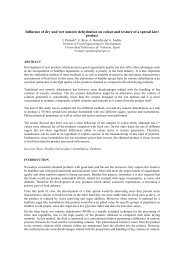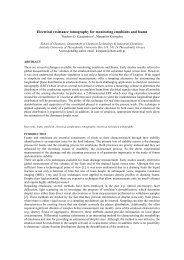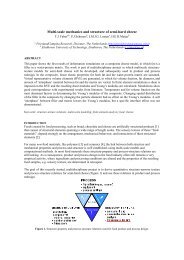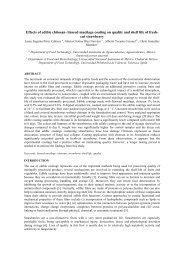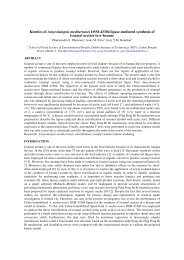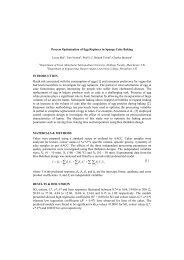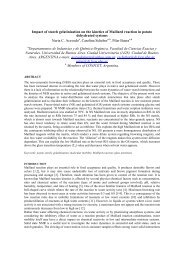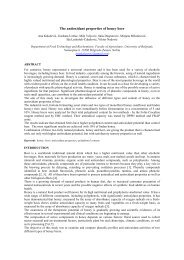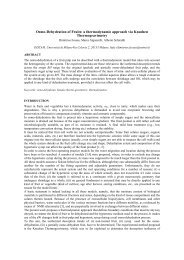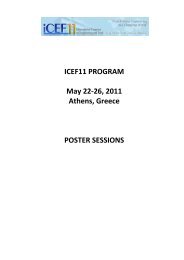Linseed Mucilage and Chitosan composite films - 11th International ...
Linseed Mucilage and Chitosan composite films - 11th International ...
Linseed Mucilage and Chitosan composite films - 11th International ...
You also want an ePaper? Increase the reach of your titles
YUMPU automatically turns print PDFs into web optimized ePapers that Google loves.
addition of less polymer (FC), these findings suggest a net increase in yellow-brown color due to incorporation of<br />
water level. Negative values of a* suggest the <strong>films</strong> had a green tint.<br />
Color<br />
20.00<br />
18.00<br />
16.00<br />
14.00<br />
b*<br />
12.00<br />
10.00<br />
8.00<br />
FA<br />
FB<br />
FC<br />
Control<br />
6.00<br />
4.00<br />
2.00<br />
0.00<br />
-3.00 -2.00 -1.00 0.00<br />
a*<br />
Figure 2. Color parameters of FA, FB <strong>and</strong> FC <strong>films</strong>.<br />
The color index (∆E*) (Table 2) is influenced by L*, a* <strong>and</strong> b* values <strong>and</strong> could describe how far apart two<br />
colors are in the color space. It was seen that ∆E* values changed upon addition of linseed mucilage polymer due<br />
to alterations in b* <strong>and</strong> a* values of film.<br />
Table 2. Color parameters of FA, FB <strong>and</strong> FC <strong>films</strong><br />
Film sample L* a* b* ∆E<br />
FA 97.01±1.02 (-)1.54±0.49 10.55±3.22 5.06±1.64<br />
FB 97.52±0.93 (-)1.71±0.28 9.88±2.33 5.06±0.81<br />
FC 96.08±1.26 (-)2.20±0.51 15.18±3.89 7.53±2.47<br />
The water vapor transmission rate of <strong>films</strong> plays an important role in deteriorative reactions of food; therefore, it<br />
is the most extensively studied property of <strong>films</strong>. Water vapor permeability is assumed to be independent of the<br />
water vapor pressure gradient applied across the <strong>films</strong>. However, hydrophilic materials, such as polysaccharide<br />
<strong>films</strong>, deviate from this ideal behavior due to interactions of permeating water molecules with polar groups in the<br />
film’s structure [14]. The WVTR values showed in Table 3. change significantly with varying concentrations of<br />
linseed mucilage polymer. In order h<strong>and</strong> the chitosan <strong>films</strong> have relatively poor water vapor barrier<br />
characteristics, which result from their hydrophilicity. Glycerol, through its plasticizing action, changes the<br />
polymer network creating mobile regions with larger interchain distances, promoting water clustering<br />
by competing with water at active sites of the polymer matrix <strong>and</strong> the formation of micro cavities in the polymer<br />
network structure. Water sorption by biopolymers often results in swelling <strong>and</strong> conformational changes. The<br />
absorbed water plasticizes the film matrix, leading to a less dense structure where chain ends are more mobile,<br />
thus increasing transmission rate [15].<br />
Table 3. WVT of <strong>films</strong><br />
Film WVT (g Pa -1 s -1 m -1 ) x 10 -10



